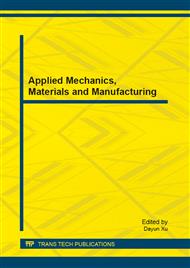[1]
T. Fujiwara, T. Kato, S. Abeyama and S. Nakamura: Effects of Free-Machining Additives on Machinability of the 18Cr-2Mo Stainless Steel. Proceedings of the International Symposium on Influence of Metallurgy on Machinability of Steel, 26. -28. September, Tokyo, pp.231-240, (1977).
Google Scholar
[2]
H. Chandrasekaran and J. Johansson: Annals of the CIRP 43, 1, pp.101-105, (1994).
Google Scholar
[3]
J. Jurko, and A. Panda: Advanced Materials Research. Vol. 314-316, pp.995-998, ISSN 1022-6680, (2011).
Google Scholar
[4]
J. Jurko, A. Panda and M. Behún: Applied Mechanics and Materials. Vol. 224, pp.204-207, ISSN 1660-9336, (2012).
Google Scholar
[5]
J. Jurko, A. Panda and M. Behún: Applied Mechanics and Materials. Vol. 224, pp.142-145, ISSN 1660-9336, (2012).
Google Scholar
[6]
J. Jurko, A. Panda, M. Behún, A. Berdis, J. Gecák, M. Gecík and P. Orendáč: Applied Mechanics and Materials, Vol. 217-219, pp.2202-2205, ISSN 1660-9336, (2012).
DOI: 10.4028/www.scientific.net/amm.217-219.2202
Google Scholar
[7]
J. Jurko, and A. Panda: Applied Mechanics and Materials, Vol. 229-231, pp.415-418, ISSN 1660-9336, (2012).
Google Scholar
[8]
J. Jurko: Advanced Materials Research, Vol. 291-294, pp.2987-2990, ISSN 1022-6680, (2011).
Google Scholar
[9]
A. Panda, J. Duplák, J. Jurko and M. Behún: Advanced Materials Research. Vol. 340, pp.30-33, ISSN 1022-6680, (2011).
DOI: 10.4028/www.scientific.net/amr.340.30
Google Scholar
[10]
J. Jurko, A. Panda, T. Zaborowski and M. Gajdoš: Progressive Machining - drilling of holes - theory and experience. Gorzów Wlkp. : IBEN, 190 p., ISBN 978-83-932166-9-7, (2012).
Google Scholar
[11]
J. Jurko, A. Panda and T. Zaborowski: Study of Evaluation Machinability of a Stainless Steels and Accompanying Phenomena in the Cutting Zone during Machining. Trends in Vital Food and Control engineering. Rijeka : InTech, pp.235-262, ISBN 978-953-51-0449-0, (2012).
DOI: 10.5772/34530
Google Scholar
[12]
J. Jurko, M. Džupon, A. Panda and J. Zajac: Advanced Materials Research. Vol. 538-541, pp.1312-1315, ISSN 1022-6680, (2012).
DOI: 10.4028/www.scientific.net/amr.538-541.1312
Google Scholar
[13]
J. Jurko and A. Panda: Simulation of accompanying phenomena in the cutting zone during drilling of stainless steels. 3rd International Conference on Advanced Computer Theory and Engineering, Proceedings, Chengdu : 20. -22. August 2010, Vol. 1, pp. V1239-V1243, (2010).
DOI: 10.1109/icacte.2010.5579026
Google Scholar
[14]
J. Jurko: Verification of cutting zone machinability during drilling of austenitic stainless steels, Proceedings of SPIE - The International Society for Optical Engineering, Vol. 7375 H, (2009).
DOI: 10.1117/12.839061
Google Scholar
[15]
J. Jurko, A. Panda and M. Gajdoš: International Journal of Machining and Machinability of Materials, Vol. 5, Issue 4, pp.383-400, (2009).
Google Scholar


